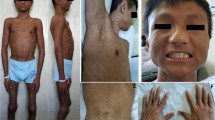Abstract
We report a case of a young male patient with clinical signs of dyskeratosis congenita who presented with multiple bilateral low-traumatic hip fractures. Whole exome sequencing (WES) showed a previously unreported mutation in the poly(A)-specific ribonuclease (PARN) gene. Zoledronic acid 5 mg over 3 years was effective at preventing further fractures. A male patient was referred to our clinic at age 24 due to multiple bilateral hip fractures. At the time of admission, the patient’s height was 160 cm and weight 40 kg; bone mineral density (BMD) at the lumbar spine was normal (L1–L4 0.0 Z-score). The patient was found to have abnormal skin pigmentation, hyperkeratosis of palms and soles, nail dystrophy, and signs of bone marrow failure (BMF). Bone fragility first presented at 5 years old with a wrist fracture, followed by multiple bilateral low-traumatic hip fractures without falls from 14 to 24 years. WES showed a previously unreported mutation (NM_002582.3: c.1652delA; p.His551fs) in the poly(A)-specific ribonuclease (PARN) gene. Flow fish telomere measurement result was 5.9 (reference range 8.0–12.6), which is consistent with the DC diagnosis. Permanent fixation with internal metal rods and zoledronic acid 5 mg over 3 years was effective at preventing further fractures over 4 years of follow-up. Additionally, BMF did not progress over 4 years of observation. DC associated with PARN gene mutations might predispose to low-traumatic multiple hip fractures in adolescents and young adults. Treatment with zoledronic acid in this case was effective and safe at preventing further fractures.

Similar content being viewed by others
References
Lessel D, Kubisch C (2019) Hereditary syndromes with signs of premature aging. Dtsch Arztebl Int 116(29–30):489–496. https://doi.org/10.3238/arztebl.2019.0489.
AlSabbagh MM (2020) Dyskeratosis congenita: a literature review. J Dtsch Dermatol Ges 18(9):943–967. https://doi.org/10.1111/ddg.14268
Alter BP, Giri N, Savage SA et al (2009) Cancer in dyskeratosis congenita. Blood 113(26):6549–6557. https://doi.org/10.1182/blood-2008-12-192880
Pignolo RJ, Suda RK, McMillan EA et al (2008) Defects in telomere maintenance molecules impair osteoblast differentiation and promote osteoporosis. Aging Cell 7(1):23–31. https://doi.org/10.1111/j.1474-9726.2007.00350.x
Niewisch MR, Savage SA (2019) An update on the biology and management of dyskeratosis congenita and related telomere biology disorders. Expert Rev Hematol 12(12):1037–1052. https://doi.org/10.1080/17474086.2019.1662720
Burris AM, Ballew BJ, Kentosh JB et al (2016) Hoyeraal-Hreidarsson syndrome due to PARN mutations: fourteen years of follow-up. Pediatr Neurol 56:62–68. https://doi.org/10.1016/j.pediatrneurol.2015.12.005
Lal M, Thakur M, Kashyap S (2016) Avascular necrosis of head of femur in dyskeratosis congenita - a rare presentation. Indian J Hematol Blood Transfus 32(Suppl 1):228–232. https://doi.org/10.1007/s12288-015-0511-8
Tummala H, Walne A, Collopy L et al (2015) Poly(A)-specific ribonuclease deficiency impacts telomere biology and causes dyskeratosis congenita. J Clin Invest 125(5):2151–2160. https://doi.org/10.1172/JCI78963
Mason PJ, Bessler M (2015) mRNA deadenylation and telomere disease. J Clin Invest 125(5):1796–1798. https://doi.org/10.1172/JCI81506
Moon DH, Segal M, Boyraz B et al (2015) Poly(A)-specific ribonuclease (PARN) mediates 3′-end maturation of the telomerase RNA component. Nat Genet 47(12):1482–1488. https://doi.org/10.1038/ng.3423
Dhanraj S, Gunja SMR, Deveau AP et al (2015) Bone marrow failure and developmental delay caused by mutations in poly(A)-specific ribonuclease (PARN). J Med Genet 52(11):738–748. https://doi.org/10.1136/jmedgenet-2015-103292
Shankar RK, Giri N, Lodish MB et al (2017) Bone mineral density in patients with inherited bone marrow failure syndromes. Pediatr Res 82(3):458–464. https://doi.org/10.1038/pr.2017.117.
Kelly TE, Stelling CB (1982) Dyskeratosis congenita: radiologic features. Pediatr Radiol 12(1):31–36. https://doi.org/10.1007/BF01221708
Nguyen HH, van de Laarschot DM, Verkerk AJMH et al (2018) Genetic risk factors for atypical femoral fractures (AFFs): a systematic review. JBMR Plus 2(1):1–11. https://doi.org/10.1002/jbm4.10024
Mamedova E, Dimitrova D, Przhiyalkovskaya E et al (2019) Non-lethal Raine syndrome in a middle-aged woman caused by a novel FAM20C mutation. Calcif Tissue Int 105(5):567–572. https://doi.org/10.1007/s00223-019-00599-w
Agarwal S (2018) Evaluation and management of hematopoietic failure in dyskeratosis congenita. Hematol Oncol Clin North Am 32(4):669–685. https://doi.org/10.1016/j.hoc.2018.04.003
Soki FN, Li X, Berry J et al (2013) The effects of zoledronic acid in the bone and vasculature support of hematopoietic stem cell niches. J Cell Biochem 114(1):67–78. https://doi.org/10.1002/jcb.24301
Acknowledgments
The authors thank Geoffrey Clayson for English editing work.
Funding
АААА-А20-120011690202-4
Author information
Authors and Affiliations
Corresponding author
Ethics declarations
Conflicts of interest
None.
Additional information
Publisher’s note
Springer Nature remains neutral with regard to jurisdictional claims in published maps and institutional affiliations.
Supplementary information
ESM 1
(DOCX 14 kb)
Rights and permissions
About this article
Cite this article
Belaya, Z., Golounina, O., Nikitin, A. et al. Multiple bilateral hip fractures in a patient with dyskeratosis congenita caused by a novel mutation in the PARN gene. Osteoporos Int 32, 1227–1231 (2021). https://doi.org/10.1007/s00198-020-05758-6
Received:
Accepted:
Published:
Issue Date:
DOI: https://doi.org/10.1007/s00198-020-05758-6




